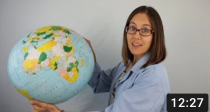Parental supervision is recommended if repeating some of these experiments at home.
- In the video, Science Mom wrapped the ends of four thermometers in napkins. She left one napkin dry and wet the other napkins with oil, water, and rubbing alcohol. Which thermometer did you predict would have the largest drop in temperature? Which one actually had the most evaporative cooling? Why was that?
- When Science Mom made a cloud in a 2 liter bottle what caused the water and rubbing alcohol to condense?
- Why did the balloon filled with the most water take longer to pop?
- If you tried any of these experiments on your own, what did you find?
Earn badges and qualify for prize drawing by registering and answering journal questions. It's fun and easy!


